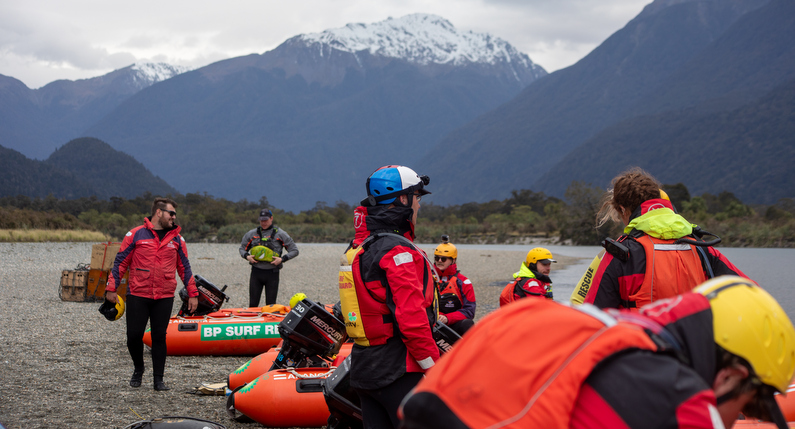
Go light, go long
The Surf Life Saving NZ Otago SAR Team testing their remote deployment capabilities in Fiordland National Park.
In October last year, a flotilla of inflatable rescue boats (IRB) spent two days navigating and searching their way through lakes, rivers, estuaries, ocean and fiords on a training exercise near Milford Sound.
Max Corboy and Brent Matehaere are staff members for Surf Life Saving New Zealand, who also volunteer as coordinators of the Surf Life Saving NZ Otago SAR Team.
“The exercise scenario was based around our initial response to AF8, a major alpine fault earthquake,” says Brent. “But our long-range remote deployment capability is equally applicable to other nationally significant SAR incidents, such as a foundering
cruise ship in Fiordland.”
Getting to the exercise area presented some logistical hurdles. “Generally, deployments are done in a single push from home, but here our teams had to prepare all their kit for two days away from base. Tents, sleeping bags and freeze-dry food were bagged up alongside wetsuits, radios and helmets. Space is limited on an IRB, so everyone had to pack light!” says Max. The Otago SAR Team has close ties with local Land Search and Rescue groups, who have assisted with advice on general skills and equipment for multi-day operations.
From the Lower Hollyford Road, the IRBs were transported by helicopter to the shores of Lake Alabaster. Just organising everything into the right number of sling net loads was a challenge, as was reassembling the parts in a remote location.
Qualified flood boat drivers got to put their skills into practice by navigating the Pyke and Hollyford rivers to a hut on the shores of Lake McKerrow. “After establishing a coordination point at the hut with Starlink capable computers, we sent the teams on a night search exercise,” says Brent. “A dozen GPS locations simulated the last known point of missing people, some washed up on the shore, others floating in the lake.” Crews searched with powerful head torches and hand held spotlights. They also used the Garmin GPSmap 67i units to plan and execute creeping line or expanding box searches. Meanwhile, the satellite tracking function of those units allowed the exercise controllers at the hut to monitor their locations in real time.
“A massive part of this activity was to test the teamwork of our Surf Lifeguards in an unfamiliar environment,” says Max. “At their home beach, they can draw on years of specific local knowledge. In Fiordland, they had to work together to develop a plan on the go. When two of the floating search targets weren’t found, it was great to hear them on the radio, coordinating a new search strategy, and executing it safely together.”
Two officers from the Otago Police SAR squad accompanied the group, providing mentorship and guidance along the way. “It was a fantastic opportunity for relationship building,” says Sergeant Matt Sheat. “The exercise confirmed the confidence we have in the capabilities of these volunteers. I’m really impressed at their initiative to train like this, preparing for major incidents beyond the usual day to day responses. They’ve built a strong capability not just with on-the-water personnel and assets, but also with communications, logistics and other supporting resources.”
The next morning, with support from an Otago Harbour Master safety vessel, the group navigated the Hollyford River bar, transited into the open sea, then back through the entrance of Milford Sound.
The final activity was in collaboration with large commercial vessels in Milford Sound. Using Stokes basket stretchers, they practised transferring mannequins from the large vessels to the IRB, simulating the transport of patients to shore if jetty infrastructure was destroyed.
Max and Brent have been organising long-range exercises like this for the past five years, which as well as providing excellent training, seem to be a hit with the volunteers. As Brent recalls, “A lifeguard with 20 years experience told me it was the best thing he’s done in Surf.”
Feature image: Courtesy Shell Cobby.
Enjoy this story?
Sign up to our Link Newsletter to receive stories like this plus NZSAR news and announcements direct to your inbox, every six weeks.
Follow NZSAR on LinkedIn for more SAR news, announcements and discussion.
This story was originally published in the April 2025 issue of Link magazine, which is produced by the NZSAR Secretariat for the wider search and rescue sector.
